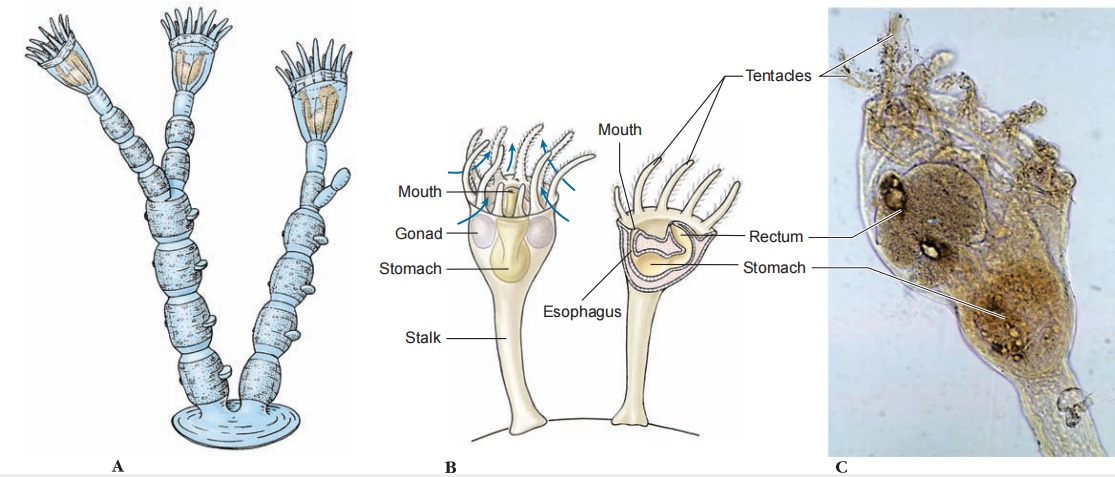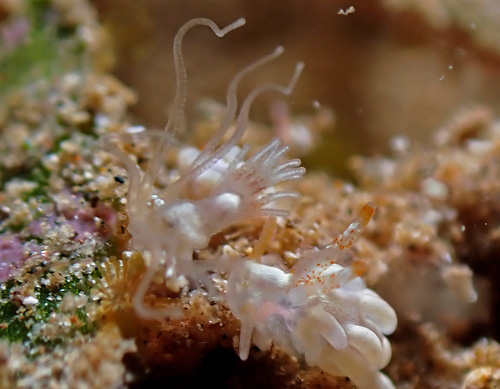Entoprocta (en’ – to-prok ‘-ta) (Gr. entos, within, + proktos, anus) is a small phylum of about 150 species of tiny, sessile animals that superficially resemble hydroid cnidarians but have ciliated tentacles that tend to roll inward. Most entoprocts are microscopic, and none is more than 5 mm long. They may be solitary or colonial, but all are stalked and sessile. All are ciliary feeders.

With the exception of Urnatella (L. urna, urn, + ellus, dim. suffix), which occurs in freshwater, all entoprocts are marine forms that have a wide distribution from polar regions to tropics. Most marine species are restricted to coastal and brackish waters and often grow on shells and algae. Some are commensals on marine annelid worms. Entoprocts occur from the intertidal to depths of around 500 m. Freshwater entoprocts occur on the underside of rocks in running water. U. gracilis is the only common freshwater species in North America.
The body, or calyx, of an entoproct is cup-shaped, bears a crown, or circle, of ciliated tentacles, and may be attached to a substratum by a single stalk and an attachment disc with adhesive glands, as in the solitary Loxosoma and Loxosomella (Gr. loxos, crooked, + soma, body), or by two or more stalks in colonial forms. Movement is usually restricted in entoprocts, but Loxosoma, which lives in the tubes of marine annelids, is quite active, moving over the annelid and its tube freely.
The body wall comprises a cuticle, cellular epidermis, and longitudinal muscles. The tentacles and stalk are continuations of the body wall. The 8 to 30 tentacles forming the crown are ciliated on their lateral and inner surfaces, and each can move individually. Tentacles can roll inward to cover and to protect the mouth and anus but cannot be retracted into the calyx. The gut is U-shaped and ciliated, and both the mouth and the anus open within the circle of tentacles.
Entoprocts are ciliary suspension feeders. Long cilia on the sides of the tentacles keep a current of water containing protozoa, diatoms, and particles of detritus moving inward between the tentacles. Short cilia on the inner surfaces of the tentacles capture food and direct it downward toward the mouth. Digestion and absorption occur within the stomach and intestine before wastes are discharged from the anus.
The pseudocoel is largely filled with a gelatinous parenchyma in which is embedded a pair of flame bulb protonephridia and their ducts, which unite and empty near the mouth. A well-developed nerve ganglion occurs on the ventral side of the stomach, and the body surface bears sensory bristles and pits. Circulatory and respiratory organs are absent. Exchange of gases occurs across the body surface, probably much of it
through the tentacles.
Some species are dioecious, but many are monoecious, most often protandrous hermaphrodites, where the gonad at first produces sperm and later eggs. Colonial forms may have monoecious or dioecious zooids, and colonies can even contain zooids of both sexes. The gonoducts open within the circle of tentacles.
Fertilized eggs develop in a depression, or brood pouch, between the gonopore and the anus. Entoprocts have a modified spiral cleavage pattern with mosaic blastomeres. The embryo gastrulates by invagination. Mesoderm develops from the 4d cell. The trochophore-like larva is ciliated and free-swimming. It has an apical tuft of cilia at the anterior end and a ciliated girdle around the ventral margin of the body. Eventually the larva settlesto a substratum and metamorphoses into an adult zooid.
Useful External Links

